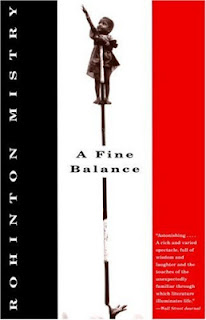A Fine Balance
Summary (from the publisher): With a compassionate realism and narrative sweep that recall the work of Charles Dickens, this magnificent novel captures all the cruelty and corruption, dignity and heroism, of India. The time is 1975. The place is an unnamed city by the sea. The government has just declared a State of Emergency, in whose upheavals four strangers--a spirited widow, a young student uprooted from his idyllic hill station, and two tailors who have fled the caste violence of their native village--will be thrust together, forced to share one cramped apartment and an uncertain future.
As the characters move from distrust to friendship and from friendship to love, A Fine Balance creates an enduring panorama of the human spirit in an inhuman state.
As the characters move from distrust to friendship and from friendship to love, A Fine Balance creates an enduring panorama of the human spirit in an inhuman state.
Review: Well, this novel was certainly eye-opening. And very difficult to get through from an emotional standpoint. Mistry's novel is set in India in 1975 and focuses on four individuals who form an unlikely friendship - Dina, a widow who is trying to survive as a single woman, Maneck, a young man traveling from his home to attend college, and two tailors who are uncle and nephew named Ishvar and Omprakash. I loved the narrative structure of this novel. Mistry opens the book with all four characters meeting for the first time, and then begins to tell each individual's family stories and how they ended up where they are. I really appreciated that the author goes back several generations in most cases to really give depth and meaning to the individual's background and outlook on life. I also enjoyed how Mistry weaves other characters in - having one character meet a person who later shows up in another main character's life. It emphasized how linked and universally human this story and its characters' suffering truly is.
The picture painted in this novel about the reality of India in the 1970s was absolutely devastating. People are tortured and killed throughout and must accept it as the status quo. Isvar and Omprakash, in particular, have a horrendous family history, since they come from a lower caste, and the conclusion of their tale was, in a word, devastating. I also was sad for Dina, who, after a sad childhood, victoriously marries the man she loves but loses him after only three short years. Her struggle to maintain her independence through having a paying guest stay with her and hiring the two tailors to work for her is what brought these four characters together in the first place.
I'm sad to say that I don't know much about the history of India in the late twentieth century, so I found this book very educational in an alarming and upsetting way. I was particularly disturbed by the "family planning" efforts during this time period which involved forced sterilization of the poor. From the beggars, hair collectors, street performers, and shop owners in this story - everyone is just hoping to survive. Perhaps most moving to me as a reader was how stoically all the characters accepted the gross and inhumane acts committed against them as their fate. That, more than anything, shows the sad reality of life revealed through this incredibly illuminating novel.
Stars: 4



Comments
Post a Comment